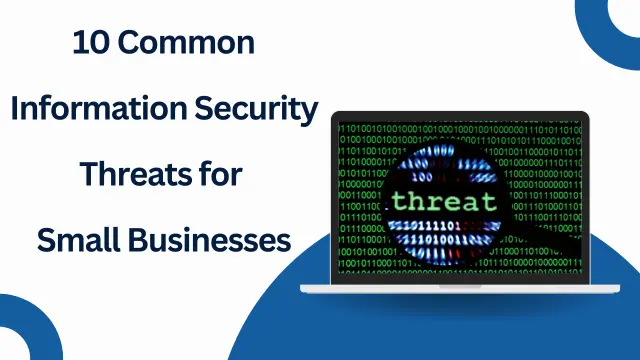
Small businesses are often targets of information security threats due to limited resources & weaker cybersecurity measures. Understanding the types of threats to information security is essential to safeguarding your organization from breaches that can lead to financial-losses, data theft, & reputational damage. These IT security threats can come in various forms, from phishing scams to ransomware attacks. As cybercriminals evolve, small businesses must stay informed about common information security threats and take preventive measures. Identifying and mitigating these security risks to organizations can significantly reduce the potential for devastating breaches.
1. Phishing Attacks
Phishing remains one of the most prevalent information security threats businesses face today. Cybercriminals often use deceptive emails or websites to lure individuals into sharing confidential details, such as login credentials or payment information. Small businesses are especially at risk since attackers target employees who may lack adequate cybersecurity training. Clicking on a suspicious link and downloading a harmful file can inadvertently compromise the company’s IT systems. To combat phishing, businesses should deploy email filtering tools and conduct regular training sessions to help employees recognize and avoid phishing scams.
2. Ransomware
Ransomware is a severe form of malware that encrypts a victim’s data and demands a ransom for release. This IT threat can result in the loss of vital business information and considerable financial repercussions. Attackers frequently exploit outdated software or use phishing methods to inject ransomware into a company’s system. To minimize the risk of ransomware, businesses must update software, back up important data regularly, and invest in strong cybersecurity software to detect threats early and mitigate damage.
3. Insider Threats
Insider threats represent a significant, often overlooked, information security threat. These threats occur when employees or contractors with legitimate access to data unintentionally or maliciously compromise the organization’s security. Insider threats can result from negligent data management or intentional misconduct, potentially exposing sensitive information or creating system vulnerabilities. To mitigate this risk, businesses should enforce strict access controls, monitor user activities, and provide employees with clear guidance on data security best practices.
4. Malware
Malware includes malicious software designed to damage or infiltrate systems, such as viruses, trojans, and worms. This IT threat can cause significant disruption to small businesses by corrupting data, stealing confidential information, or rendering systems unusable. Cybercriminals often see small businesses as easier targets due to insufficient security measures. Protecting against malware requires using firewalls, installing antivirus software, and conducting regular scans to identify and remove malicious programs before they cause damage.
5. Weak Passwords
Weak passwords are one of the organizations’ most preventable security risks. Many employees use simple, easy-to-guess passwords or reuse the same password across multiple-accounts, making it easier for cyber attackers to gain unauthorized access to systems. This practice can expose sensitive business information and increase the likelihood of a security breach. To combat weak password practices, businesses should enforce strong password policies that require complex, unique passwords and implement two-factor authentication (2FA) for an additional layer of security.
6. Unsecured WiFi Networks
Unsecured WiFi networks can allow attackers to infiltrate a business’s IT infrastructure. If a company’s wireless network is not properly secured, unauthorized individuals can intercept communications or launch attacks on connected devices. This information security threat is dangerous for small businesses that may not invest in securing their wireless networks. To protect against this risk, businesses should encrypt their Wi-Fi networks, use strong passwords, and segment guest networks from internal systems to minimize exposure.
7. Social Engineering Attacks
Social engineering is a tactic cybercriminals use to manipulate individuals into revealing confidential information and performing actions that compromise security. This type of threat to information security preys on human error rather than technical vulnerabilities. Attackers may pose as trusted figures, such as colleagues or vendors, to access sensitive data or systems. To defend against social engineering, businesses should train employees to recognize suspicious requests, verify identities before sharing information, and avoid oversharing details about their business operations.
8. Outdated Software and Systems
Many small businesses fail to regularly update their software and systems, leaving them vulnerable to attacks. Cyberattackers often exploit known vulnerabilities in outdated software to gain-access to an organization’s network. This IT security threat can lead to data breaches or system disruptions. Regularly updating software, applying security patches, and replacing unsupported systems are critical steps in reducing the risk of outdated technology.
9. Third Party Vendor Risks
Small businesses often rely on third-party vendors for cloud storage or payment processing. While these partnerships can benefit organizations, they also introduce security risks. If a third-party vendor suffers a security breach, it can directly impact the small business that relies on them. To minimize this risk, companies should conduct thorough due diligence when selecting vendors and ensure adequate security measures are in place. Additionally, businesses should maintain clear contracts that define the responsibilities & liabilities of both parties in the event of a breach.
10. Mobile Device Vulnerabilities
As more employees use mobile devices, they become a potential IT threat to small businesses. Mobile devices can be easily stolen & lost, potentially giving unauthorized individuals access to sensitive business information. Furthermore, many employees fail to secure their devices with strong passwords or encryption, making them an attractive target for cybercriminals. To mitigate the risk of mobile device vulnerabilities, businesses should implement mobile device management (MDM) solutions, enforce security policies, and educate employees on protecting their devices from threats.
Secure Your Business With Circle MSP
Protecting your small business from these common information security threats is essential to its long-term success. Circle MSP provides comprehensive cybersecurity solutions to safeguard your business from the latest IT threats. Our expert IT team ensures your business stays secure and compliant with phishing prevention and ransomware protection.
Contact us to know how we can help you mitigate security risks to organizations and strengthen your overall cybersecurity posture. Let us be your trusted IT partner in protecting your business from evolving threats.
